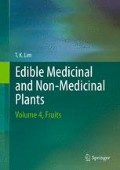Abstract
Java Long Pepper occurs wild in Indonesia, Malaysia, Philippines, Thailand and Vietnam. It is also found in the Ryuku Islands and Yunnan, and is cultivated in Guangdong, China and Kampuchea. Long pepper is cultivated only to a limited extent on Java, Bali and some neighbouring islands, as the species occurs in sufficient quantities in the wild.
Access this chapter
Tax calculation will be finalised at checkout
Purchases are for personal use only
Selected References
Ahn JW, Ahn MJ, Zee OP, Kim EJ, Lee SG, Kim HJ, Kubo I (1992) Piperidine alkaloids from Piper retrofractum fruits. Phytochemistry 31(10):3609–3612
Atal CK, Ojha JN (1965) Studies on the genus Piper. Part IV. Long peppers of Indian commerce. Econ Bot 19:157–164
Backer CA, Bakhuizen van den Brink RC Jr (1963) Flora of Java, vol 1. Wolter-Noordhoff, Groningen, 647pp
Banerji A, Bondopadhyay D, Sarkar M, Siddhanta AK, Pal SC, Ghosh S, Abraham D, Shoolery JN (1985) Structural and synthetic studies on the retrofractamides - amide constituents of Piper retrofractum. Phytochemistry 24:279–284
Banerji A, Sarkar M, Datta R, Sengupta P, Abraham K (2002) Amides from Piper brachystachyum and Piper retrofractum. Phytochemistry 59(8):897–901
Bhandari SPS, Babu UV, Garg HS (1998) A lignan from Piper chaba stems. Phytochemistry 47(7):1435–1436
Bodiwala HS, Singh G, Ranvir Singh R, Dey CS, Sharma SS, Bhutani KK, Pal I (2007) Antileishmanial amides and lignans from Piper cubeba and Piper retrofractum. J Nat Med 61(4):418–421
Burkill IH (1966) A dictionary of the economic products of the Malay Peninsula. Revised reprint. 2 vols. Ministry of Agriculture and Co-operatives, Kuala Lumpur, vol 1 (A–H), pp 1–1240, vol 2 (I–Z), pp 1241–2444
Chansang U, Zahiri NS, Bansiddhi J, Boonruad T, Thongsrirak P, Mingmuang J, Benjapong N, Mulla MS (2005) Mosquito larvicidal activity of aqueous extracts of long pepper (Piper retrofractum Vahl) from Thailand. J Vector Ecol 30(2):195–200
Chaveerach A, Piya Mokkamul P, Sudmoon R, Tanee T (2006) Ethnobotany of the genus Piper (Piperaceae) in Thailand. Ethnobot Res Appl 4:223–231
ENVIS (2010) Medicinal plants of conservation concern. Environmental information System (ENVIS) Centre, Foundation for Revitalisation of Local Health Traditions (FRLHT), Ministry of Environment and Forests, India. http://envis.frlht.org/about_envis.htm
Jaijoy K, Vannasiri S, Piyabhan P, Lerdvuthisopon N, Boonraeng S, Khonsung P, Lertprasertsuke N, Sireeratawong S (2010) Acute and subchronic toxicity study of the water extract from the fruits of Piper chaba Hunter in rats. Int J Appl Res Nat Prod 3(4):29–35
Jyothi D, Vanathi P, Mangala Gowri P, Rama Subba Rao V, Madhusudana Rao J, Sreedhar AS (2009) Diferuloylmethane augments the cytotoxic effects of piplartine isolated from Piper chaba. Toxicol In Vitro 23(6):1085–1091
Kim KJ, Lee MS, Jo K, Hwang JK (2011) Piperidine alkaloids from Piper retrofractum Vahl. protect against high-fat diet-induced obesity by regulating lipid metabolism and activating AMP-activated protein kinase. Biochem Biophys Res Commun 411(1):219–225
Mahavorasirikul W, Viyanant V, Chaijaroenkul W, Itharat A, Na-Bangchang K (2010) Cytotoxic activity of Thai medicinal plants against human cholangiocarcinoma, laryngeal and hepatocarcinoma cells in vitro. BMC Complement Altern Med 10:55
Matsuda H, Ninomiya K, Morikawa T, Yasuda D, Yamaguchi I, Yoshikawa M (2008) Protective effects of amide constituents from the fruit of Piper chaba on D-galactosamine/TNF-a-induced cell death in mouse hepatocytes. Bioorg Med Chem Lett 18(6):2038–2042
Matsuda H, Ninomiya K, Morikawa T, Yasuda D, Yamaguchi I, Yoshikawa M (2009) Hepatoprotective amide constituents from the fruit of Piper chaba: structural requirements, mode of action, and new amides. Bioorg Med Chem 17(20):7313–7323
Morikawa T, Matsuda H, Yamaguchi I, Pongpiriyadacha Y, Yoshikawa M (2004) New amides and gastroprotective constituents from the fruit of Piper chaba. Planta Med 70(2):152–159
Morikawa T, Yamaguchi I, Matsuda H, Yoshikawa M (2009) A new amide, piperchabamide F, and two new phenylpropanoid glycosides, piperchabaosides A and B, from the fruit of Piper chaba. Chem Pharm Bull(Tokyo) 57(11):1292–1295
Nakatani N, Inatani R, Ohta H, Nishioka A (1986) Chemical constituents of peppers (Piper spp.) and application to food preservation: naturally occurring antioxidative compounds. Environ Health Perspect 67:135–142
Purseglove JW (1968) Tropical crops: dicotyledons. 1 & 2. Longman, London, 719pp
Rao VRS, Kumar GS, Sarma VUM, Raju SS, Babu KH, Babu KS, Babu TH, Rekha K, Rao JM (2009) Chabamides F and G, two novel dimeric alkaloids from the roots of Piper chaba Hunter. Tetrahedron Lett 50(23):2774–2777
Rukachaisirikul T, Prabpai S, Champung P, Suksamrarn A (2002) Chabamide, a novel piperine dimer from stems of Piper chaba. Planta Med 68(9):853–855
Tanaka Y, Nguyen VK (2007) Edible wild plants of Vietnam: the bountiful garden. Orchid Press, Bangkok, 175pp
Taufiq-Ur-Rahman M, Shilpi JA, Ahmed M, Faiz Hossain C (2005) Preliminary pharmacological studies on Piper chaba stem bark. J Ethnopharmacol 99(2):203–209
Tseng YC, Xia N, Gilbert MG (1999) Piperaceae C. Agardh. In: Wu ZY, Raven PH (eds) Flora of China, vol 4 (Cycadaceae through Fagaceae). Science Press/Missouri Botanical Garden Press, Beijing/St. Louis
Uphof JC Th (1968) Dictionary of economic plants, 2nd edn. (1st edn. 1959) Cramer, Lehre, 591pp
Utami D, Jansen PCM (1999) Piper L. In: de Guzman CC, Siemonsma JS (eds) Plant resources of South-East Asia No 13 Spices. Backhuys Publishers, Leiden, pp 183–188
Author information
Authors and Affiliations
Corresponding author
Rights and permissions
Copyright information
© 2012 Springer Science+Business Media B.V.
About this chapter
Cite this chapter
Lim, T.K. (2012). Piper retrofractum. In: Edible Medicinal And Non-Medicinal Plants. Springer, Dordrecht. https://doi.org/10.1007/978-94-007-4053-2_42
Download citation
DOI: https://doi.org/10.1007/978-94-007-4053-2_42
Published:
Publisher Name: Springer, Dordrecht
Print ISBN: 978-94-007-4052-5
Online ISBN: 978-94-007-4053-2
eBook Packages: Biomedical and Life SciencesBiomedical and Life Sciences (R0)

